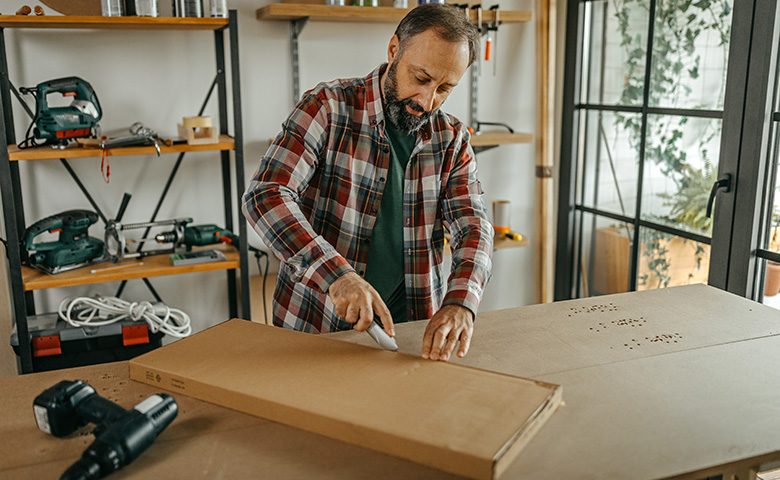Knives are useful tools used in a variety of workplace settings, but using utility knives, box cutters and other cutting tools always involve the risk of injury. If your staff are handling knives, even for occasional use only, your company should take steps to train workers on proper knife safety. In addition to wearing PPE, the following five steps are excellent building blocks for promoting knife safety and reducing knife injuries.
Choose the right tool for the job
The first step to workplace knife safety and knife injury prevention is to provide employees with the most appropriate knife for the job. Companies should invest in quality knives and have a maintenance program to keep them sharp and in good working order. Once equipped, educate and train workers on the knives in your workplace. Take time to emphasize why they are designed the way they are and what they do well. The idea is to have staff understand and respect the utility of each knife in the workplace and to recognize how to use them appropriately. Incidents are much more likely to happen when workers are in the habit of simply using the nearest sharpest object, rather than taking the time to use the knife designed for the task at hand.
This education should include making your staff aware of the dangers of using a dull knife. A sharp blade can cut much easier, requiring less force from the user. As a blade becomes dull, workers will have to use more and more strength to get the job done, and as a result, it significantly increases the chance of an injury occurring.
If workers routinely use improper tools for cutting then you may need to put greater emphasis on supervisor training. Help frontline leaders notice when workers are using knives or other tools incorrectly, and train them to effectively intervene and help employees build new habits.
Provide a good work surface
When operating a knife in the workplace, a clean, level and stable work area is imperative to avoiding injury. Incorporate the ‘where’ into knife safety training. Allocate designated spaces for knife use and ensure they are well-lit. Knife stations should be out of high traffic areas as much as possible, to guard against the knife-wielder’s elbows getting bumped. If space restrictions in your workplace make it difficult to establish a designated area for knife use, it’s still important to take steps to ensure that the work surface is clear and in an area that’s conducive to safely handling a knife.
Inspect the knife before use
Before beginning knife work, teach workers how to carefully inspect the knife for any damage and to ensure it’s clean and sharp. Working with a faulty blade—whether it’s chipped, cracked, loose, dull, or otherwise altered—can easily result in injury. A damaged knife can be hard to control. A knife with a chip or crack is much more likely to break during use; broken pieces of a blade can become dangerous projectiles capable of causing serious damage.
Because it’s relatively rare to find an issue when inspecting a utility blade or other cutting tool, there is a risk of workers becoming complacent about the risks involved in handling them. Emphasize the importance of making sure the guards and blades on utility knives are inspected before each use. Supervisors are encouraged to communicate to staff the dangers of using damaged blades. Also consider telling safety stories about injuries sustained by a damaged knife that wasn’t properly inspected prior to use, and including knife-related issues in toolbox talks.
Focus while working
When working with knives, it’s essential for employees to focus on the task at hand. Distraction is a major contributor to incidents when working with knives. Help workers get in the habit of not talking to others while handling a knife. If a worker’s attention has to shift elsewhere, train them to stop cutting and put the knife down. Other important knife safety habits include always cutting away from your body, and checking hand position before cutting to confirm that nothing is in the line of fire. Demonstrations, frequent conversations and toolbox talks are all ways to strengthen habits and monitor how effectively those habits have taken root.
Proper storage
The safe storage of knives is a crucial component to knife safety in the workplace as is safe handling of discarded blades as they’re removed from service. When finished working with a knife, the best practice is to clean the knife and then put it away in a secure and labeled area. Encourage staff to never just leave knives lying around. Knives that are left in places where they can’t be seen, such as thrown into a sink or on a work surface, are of particularly high risk. Spent blades shouldn’t be simply thrown in the garbage. Have labeled receptacles or a process for discarding them safely.
At the end of a work shift, fatigue and other human factors can affect whether employees put their knives away properly. So while knife storage may seem like a simple issue, a number of behavioral influences can sway workers’ actions. Human factors training can cut down on the impact of tiredness and other issues, and also help workers be much more open to the prospect of building sturdy knife safety habits.

